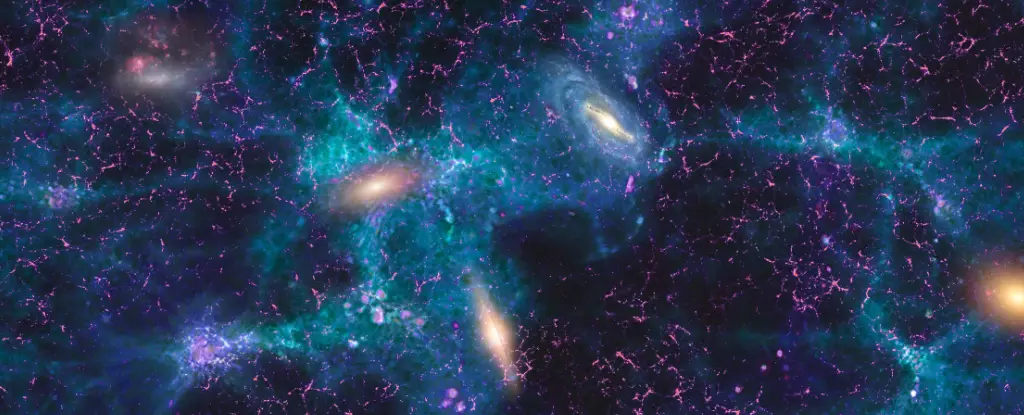In recent years, advances in cosmology have illuminated the enigmatic nature of our universe, revealing a conspicuous tension in the measurements of its expansion. This tension represents a dilemma for physicists as they seek to reconcile varying findings related to the Hubble constant—a critical value in determining the rate at which galaxies are receding from us. Recent studies on distant galaxy clusters, such as the Coma Cluster, have fueled this debate, demonstrating that the cosmos is expanding faster than conventional physics can readily explain.
For nearly 100 years, the concept of an expanding universe has garnered support through observations of distant galaxies and their shifting positions within the cosmic fabric. The principal idea rests on the premise that all mass and energy were once confined within a dense state, which subsequently ignited a gradual increase in spatial dimensions known as cosmic inflation. This expansion is theorized to result from a delicate interplay between gravitational attraction and a mysterious form of energy dubbed dark energy.
Yet, as scientists continue to probe deeper into this cosmos, they encounter a juxtaposition between two distinct observational methodologies for measuring the Hubble constant. By evaluating the light emitted from Type Ia supernovae—explosions of white dwarf stars that follow a consistent luminosity pattern—they can infer distance and thereby estimate the recessional velocity of galaxies. Conversely, the cosmic microwave background radiation offers a glimpse into the universe’s infancy, yielding a markedly different estimation of the Hubble constant.
The conflict arises when measurements reveal a perplexing inconsistency. On one hand, contemporary methods involving supernovae suggest a Hubble constant of approximately 76.5 kilometers per second per megaparsec. In stark contrast, analyses anchored in ancient cosmic background radiation yield a figure closer to 67.4 kilometers per second per megaparsec. This discrepancy ignites passionate discussions among scientists and raises fundamental questions about our understanding of the universe’s evolution.
Dan Scolnic, an astute physicist at Duke University, is at the forefront of confronting this crisis. His recent research harnesses data from the Dark Energy Spectroscopic Instrument (DESI) to measure the distances of galaxies with enhanced accuracy. By confirming the Coma cluster’s distance to be roughly 321 million light-years away, the study bolsters our understanding of the universe’s expanding nature. However, the underlying question of why two entirely different methods yield disparate results remains unanswered.
Exploring Possible Explanations: New Physics or a Miscalculation?
The implications of this tension extend far beyond mere numbers. Scientists must now grapple with the possibility that our current models, which have successfully guided cosmological understanding for decades, may require reevaluation. Is it conceivable that we are on the cusp of uncovering new physics that could reshape our entire comprehension of the universe? Such a revelation could fundamentally alter the trajectories of cosmological research and lead to substantial paradigm shifts.
Alternatively, the discord might stem from inherent misassumptions in existing methodologies. Scolnic’s research highlights the necessity of refining each measurement process to incrementally enhance precision. By delving deeper, scientists hope to identify potential sources of error or constraints that might be influencing their findings, thus narrowing the-interpretative gap.
The Road Ahead: A Collective Effort in Cosmology
As discussions surrounding these tensions gain momentum, it’s clear that cosmologists are at a pivotal juncture in their understanding of the universe. The entire scientific community must prioritize collaboration in experimentation and data analysis to grapple with the pressing issues that have arisen. Innovators across various disciplines must converge, utilizing fresh approaches to dissect these conflicts and continue pushing the boundaries of our understanding.
Ultimately, the quest for knowledge persists—not just as an academic pursuit but as an opportunity to challenge our existing paradigms and invigorate our imaginations. Each discovery carries the potential to reshape our understanding of the universe from its origins to its expansive future, igniting excitement and curiosity that propels both scientists and the broader public alike.
As astronomers peer deeper into the cosmos, what remains abundantly clear is the paradox of our pursuit. Despite centuries of study, revelations about the universe often lead to more questions than answers. The accelerating expansion adds complexity to an already intricate cosmic narrative, pushing scientists towards uncharted territory. While the tensions surrounding the Hubble constant may initially appear daunting, they also reflect the incredible journey humankind has embarked upon in exploring the depths of the cosmos—a mystery that continuously evolves, inviting future generations into a realm governed by both wonder and inquiry.


Leave a Reply